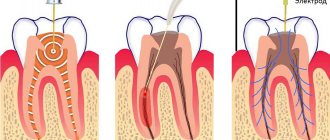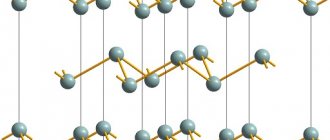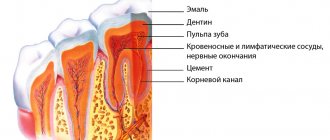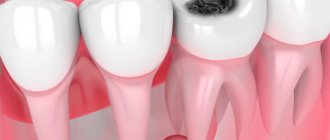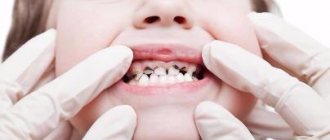04.01.2020
The operation to remove the nerve of a tooth is familiar to almost everyone who treated teeth in Soviet times or in the 90s. Not surprisingly, most people associate this procedure with arsenic being placed inside the tooth, followed by pain for several days. The memories are terrifying... But is it worth it to be afraid of this procedure now, when the modern industry has made a significant leap forward and modern dental services have appeared in all cities.
The first thing worth saying is that arsenic is a thing of the past. In addition, dentists use modern equipment and innovative materials, including for removing the nerve of a tooth. As a result, the process takes much less time, and the procedure itself is absolutely painless.
Removing the nerve allows you to protect other teeth and maxillofacial tissue from further development of the inflammatory process and the appearance of infectious diseases of the oral cavity.
First, we suggest you figure out what the nerve of a tooth is and when can a dentist decide to remove it?
Tooth removal
Depulpation (depulpation of a tooth) is the removal of pulp, connective tissue consisting of blood vessels and nerve endings. Removing the tooth nerve and cleaning the canals is designed to relieve the patient from pain, inflammation and further complications. However, the tooth, having lost its blood supply, becomes dead and, therefore, more fragile.
Dental treatment and nerve removal is one of the most common dental procedures. This is partly because patients turn to the dentist only in case of unbearable pain, when it is no longer possible to do without depulpation. Removing the nerve of the tooth and filling the canals allows you to preserve the natural tooth, which is a priority for endodontic treatment.
Indications for depulpation:
- extensive caries
- classic pulpitis and infectious pulpitis (bacteria penetrate through the root apex)
- trauma and damage to the tooth affecting the pulp
- if it is necessary to install crowns or classic bridges
Many patients who come to the dentist's office with toothache are interested in the question: is it possible to save the pulp? Today, there are methods of biological treatment (preservation of the entire pulp) and vital amputation (preservation of the root pulp), but many favorable factors must converge for them to be carried out. For example, biological treatment is not carried out after 25 years.
Composition of arsenic filling
A dosage of arsenic from 5 to 50 mg is considered dangerous. It is strictly forbidden to use the substance in its pure form. It is included in the medicinal paste.
In addition to arsenic, its components are the following:
- various anesthetics (Novocaine, Lidocaine or Dicaine);
- antiseptic solutions (for example, Timol);
- tannin;
- fillers that give the composition a paste-like consistency.
After placing a special arsenic-based paste into the cavity, the pulp cells die. As a result, its blood supply is completely suspended, and the transmission of nerve impulses stops. This is the first stage of treatment for pulpitis, in which the pain syndrome should be relieved. It is impossible to cure this pathology without removing the nerve. However, in order to perform all the manipulations as painlessly as possible, you must first kill the nerve process.
After applying the paste, the dentist covers the affected area of the tooth with a temporary filling. Its main function is to protect the composition from possible loss. As a rule, after fixation, the tooth may still hurt for 2-3 days. If it aches a lot, you can rinse it with a weak solution of soda.
Removal of tooth nerve with arsenic
Removing pulp using arsenic is considered an outdated treatment method, which is almost never used today. The procedure was quite simple: the tooth was prepared using a drill, then the root canals were expanded, medicine was applied to remove the nerve in the tooth, after which a temporary filling was installed for 2 - 3 days. The negative side of such treatment is that arsenic is a strong poison that has a detrimental effect on both the tooth and the tissues surrounding it. With the advent of new safe techniques, the need for arsenic has disappeared.
Modern pulp removal
Today, it is enough to go to the dentist once to remove the pulp. The doctor gives an anesthetic injection and calmly works with the tooth, removing the destroyed layer of dentin, extracting the pulp, treating and filling the canal. Sometimes inspection using a microscope is possible. To be on the safe side, your doctor may place a filling temporarily to make sure he has completely removed the pulp. And only if everything turns out to be in order, the final filling is installed.
Incomplete removal of the pulp is also possible, which makes sense if only the outer part of the pulp is affected by inflammation. Dead tissue is removed from the opened tooth, the outermost part of the pulp is removed, and the root remains intact. This is especially important on children's teeth, since the pulp is responsible for the formation of roots. When the pulp is not completely removed, the tooth is kept alive, and further destruction occurs more slowly.
Modern method of depulpation
Today, depulpation is carried out using a pulp extractor - a thin metal rod with teeth that can penetrate even remote areas of the root canals. The apex locator device helps determine the depth of the canal to reduce the risk of injury. After the procedure, a temporary filling is usually installed, but a permanent one can also be installed if the doctor does not see the risks of complications and has high-precision instruments on hand, for example, a dental microscope.
Anesthesia
Almost always, the nerve is removed under local anesthesia; usually, instead of the upcoming operation, the required dose of the drug is administered using a syringe. Immediately before the injection, the gums are treated with a special spray or gel containing an anesthetic, so even the slightest discomfort is eliminated. The needles used are as thin as possible.
There are several of the most common drugs used by dentists for pain relief: mepivacaine, ultracaine, articaine with epinephrine or pure. These products prevent the onset of pain; they are suitable even for people with chronic diseases, pregnant women and those prone to allergic reactions.
A gel with lidocaine is also actively used, which is placed around the diseased tooth. In this case, the patient feels as relaxed as possible and does not have any unpleasant sensations. In rare cases, pain may occur due to an incorrectly administered drug or due to the individual reaction of the patient's body. If you have a strong fear of dentists or serious psychological disorders, nerve removal can be performed under general anesthesia.
Tooth after depulpation - complications
A fragment of the instrument remained in the dental canal
A common complication associated with negligence or inexperience of the doctor. Repeated treatment involves removing instrument fragments and refilling the canals. Due to a number of factors, removal of a foreign body can be very difficult. Pain after removal of a nerve in a tooth does not occur very often, so in some cases the doctor recommends leaving everything as it is if the complication does not manifest itself.
Incompletely removed nerve or insufficient filling of dental canals
The most common reason for pain after depulpation. In such a situation, an inflammatory process develops that spreads to the root apex, provoking the formation of periodontitis, gumboil and cysts. If your tooth aches after nerve removal (several days or more), then you need to consult a doctor who can check the quality of the tooth canal filling.
Resealing
Extraction of filling material beyond the root apex. In mild cases (with a small amount), the tooth hurts when pressed for some time after the nerve is removed, after which the pain goes away. If the excess material is large, then surgical intervention is necessary to avoid the development of complications.
Perforation of the wall or root
Mechanical damage that leads to the formation of a perforation (hole) in the wall, floor of the tooth cavity or root. After the nerves are removed, the tooth continues to hurt. The pain is usually aching and paroxysmal.
Darkened tooth after nerve removal
If the tooth darkens after removal of the nerve, this may be caused by poor filling material or poorly performed depulpation. Also, over time, a dead tooth can become cracked and more vulnerable to dyes. This is partly why the front tooth, after removing the nerve, is subsequently covered with a crown or veneer.
Arsenic paste therapy
Dental treatment with arsenic-based paste is most often performed on adult patients. Normally, there should not be any severe pain. Their appearance and non-cessation within several days is an alarming symptom.
| Period of action of arsenic-based paste | Pain syndrome is normal | Pain syndrome - pathology |
| Modern dentistry uses high-quality materials. In this case, the arsenic filling must be kept for no more than 1-5 days. The maximum period is 1 week. If the pain does not go away after all the manipulations, you need to take a tablet of any non-steroidal anti-inflammatory drug. Then use a sterile needle to pick out the filling and very carefully remove the paste ball from the cavity. After completing the procedure, it is recommended to rinse with chamomile decoction. | Normally, the patient may experience pain. In this case, the pain is predominantly aching in nature and should tend to subside. After treatment, the tooth may bother you for 2-3 hours. If a person has a high pain threshold, this period is extended to 3 days. | Pain that does not go away after 3 days is considered pathological. At the same time, discomfort periodically increases. Also considered pathological is the situation when swelling and hyperemia of the mucous membranes appear and the temperature rises. In these cases, you need to get a second appointment with the dentist as soon as possible. |
In pediatric dentistry today, arsenic-based pastes are not used for therapeutic purposes. The risk of intoxication or complications far outweighs the potential benefit. Young patients are usually offered alternative therapy options. Parents, in turn, should ask the doctor in advance about which treatment method will be used.
Alarming symptoms
The most common sign of an allergic reaction is swelling. The symptom requires removal of the arsenic paste from the pulp. If swelling occurs, you should take any antihistamine and consult a doctor. If you cannot visit the dentist, you can try to extract the medicine yourself.
Hyperemia and soreness of the gums indicate that the components of the paste have reached the mucous membrane. In this case, the arsenic must be immediately removed and the affected area washed. The cause of this complication is usually a medical error.
Darkening of the enamel also indicates incorrect actions on the part of the doctor. Darkening develops due to the fact that the arsenic paste remains in the tooth longer than usual. As a result, not only the nerve endings die, but also the dentin tissue itself. There is only one solution to this problem - you must immediately remove the composition and apply a special product. If you consult a doctor in a timely manner, you can return the enamel to its standard color. All changes are reversible.
Nausea and weakness, severe headaches are obvious manifestations of intoxication. Arsenic paste used for therapeutic purposes is usually used in minimal quantities. Therefore, this composition is considered safe for human health. However, a small probability of poisoning is still present. If nausea and vomiting occur, you need to remove the composition from the tooth yourself as quickly as possible, then consult a doctor. The specialist should prescribe medications to improve your well-being.
What is a nerve and how many are there in a tooth?
A tooth consists of several parts. Enamel is the top, most durable layer. It protects the underlying tissue - fairly dense but porous dentin. The infection slowly destroys it and spreads beyond the crown of the tooth, into the root canals. The first thing on the way is pulp. This is a neurovascular bundle consisting of a different number (from 1 to 3) of nerve endings and blood vessels. They are the ones who nourish the tooth, maintain its strong structure and vital functions. In addition, the pulp protects the connective tissues of the periodontium from infection and immediately reports it through pain and temperature sensitivity. When the nerve is removed, the tooth is left without nutrition and protection, and therefore becomes more fragile and susceptible to chipping. It is considered dead, although it retains its functionality.
Is it possible to put arsenic in a tooth?
Arsenic is a chemical element that belongs to immunotoxic substances, that is, poisons.
It disrupts the exchange of selenium, sulfur and phosphorus in tissues, which leads to a lack of oxygen, hypoxia and, as a result, cell death. In dentistry, it is not pure arsenic that is used, but a paste with arsenous acid anhydride in combination with various anesthetic and antiseptic components. Below, by arsenic we will mean a paste, and not a pure chemical element.
The toxin was first used for dental treatment in 1836. Nowadays, treatment methods have changed significantly, but in some cases dentists still use acid.
In the article Stom-Firms.ru we will tell you why arsenic is placed in the tooth during treatment. We will describe how and for how long it is placed, and also list the complications that may arise.
Contraindications for depulpation
Dental pulp cannot be excised if:
- sore throat, flu, ARVI;
- infectious hepatitis;
- any form of stomatitis;
- psychoemotional disorders;
- acute forms of heart and vascular diseases;
- hemorrhagic diathesis;
- acute leukemia;
- inflammation and suppuration in the mouth.
In addition, removal of the dental nerve is contraindicated during pregnancy and lactation.
Why is it not necessary to remove the nerve to install crowns?
The need to remove the nerve arises primarily when the tooth is completely destroyed. It can also be dictated by the qualifications of the doctor: when heating or deeply removing the top layer, there is a risk of damage to the nerve endings, and this is very painful. That is why many dentists prefer a safer route, that is, preliminary removal of the nerve. Especially in the presence of the initial stage of caries.
In addition, depulpation can be performed in a number of cases before prosthetics: with increased sensitivity, with small sizes and in the presence of more than 15-degree inclination of the teeth. The pulp may also be removed for aesthetic reasons.
It is not necessary to perform depulpation before installing crowns, since the nerve can always be removed through the top of the crown.
After depulpation, the hole is filled. The main disadvantage of this procedure is the exposed tooth root, which can cause complications in the future.
Does it hurt or not?
The sensitivity of teeth is provided by a nerve that is located in the pulp tissue. For this reason, both the pathology itself and the process of its elimination presuppose the presence of pain.
Dentistry has ample opportunities for painless treatment of pulpitis. Anesthesia is used for this. Modern drugs are safe and do not pose a risk to the child’s health.
Methods of dental anesthesia.
- Local anesthesia. An anesthetic is injected into the soft tissues, eliminating any sensation for a certain period of time. To ensure that the child does not feel the injection, topical anesthesia is additionally used.
- Sedation. The method is also called “medicated sleep.” Pain relief is achieved by placing the child under a mild general anesthesia. To administer the anesthetic, intravenous and inhalation methods are used. The duration of anesthesia is from 10 minutes to 2 hours.
When treating young children under 5 years of age, dentists give preference to medicated sleep. It is difficult for a child to simultaneously cope with fear and maintain a calm position, which can complicate the procedure and cause tissue injury. Sedation allows you to eliminate psychological trauma and any painful sensations, as well as make the dentist’s work easier and speed up the treatment process.
What does tooth color change mean after pulp removal?
Nowadays, almost all private dental clinics adhere to international depulpation protocols, but outdated practices are still in use in budgetary medical institutions. The main reasons for tooth discoloration are improper preparation of the cavity for installation of a filling, poor quality of instrumentation of the canal and poor materials for filling. For example, when using endomethasone, the enamel turns yellow (a similar outcome is even prescribed in the instructions). If resorcinol-formalin paste was used for filling, the teeth may turn pink. Most often, this material is used in the treatment of baby teeth.
The nerves from wisdom teeth, which dentists call “problem eights,” are extremely rarely removed. Given their location and short service life, as well as the difficulty of cleaning from stone and plaque, they are easier to remove. As a rule, the figure eight is removed in case of incorrect eruption (if there is a slope towards the tongue or towards the cheek), tooth retention, carious lesions, pulpitis, changes in bite, displacement of the dentition.
After depulpation, you should adhere to the following recommendations:
- Avoid physical activity for the first 2 hours after the procedure.
- To avoid infection and injury to the tooth, do not eat food for 3 hours after pulp removal (you can drink warm water through a straw).
- For 5 days, exclude rough, solid foods from the diet.
- To avoid irritation of the oral mucosa, it is advisable not to smoke, drink alcoholic beverages, or eat spicy, cold or hot foods for at least 5 days.
- Rinse your mouth with antiseptics prescribed by your dentist for at least 1 day.
It is impossible to remove the dental nerve using folk remedies. Even if it can be destroyed, the pulp will need to be removed, and this can only be done with a special medical instrument.
When planning a visit to the dentist, remember that the longer you delay, the more difficult and expensive depulp removal will be. And do not forget that such intervention is recommended only if there are good reasons for it. Any dentist will try his best to keep the tooth “alive” if possible.
Pain Management Options
The duration of action of a standard anesthetic injection is 45 minutes. Patients who are afraid of injections are offered treatment of the depulpation site with a special paste-like composition of a similar effect. Tablet analgesics may reduce the effectiveness of anesthesia, so dentists do not recommend their use.
The dentist chooses the painkiller, as well as the dosage. Since everyone's pain threshold is different, the dose of anesthetic is often doubled or tripled. If the doctor has administered anesthesia according to the protocol, the patient will not feel any pain or discomfort.
How to kill a dental nerve: home methods
Even in the 21st century, some people are so afraid of going to the dentist that they are ready to do anything to avoid going to the doctor. They try to kill the dental nerve at home. There are the following methods for this:
- Powder. It is believed that a little gunpowder sent into the mouth can destroy the dental nerve (although this method is very suspicious);
- Newspaper. For this method of “treatment” you will need a sheet of newspaper with large drawings. It needs to be crushed and burned on a plate. Then very quickly wipe off the yellow residue that has formed on the plate and the remaining ash with a cotton pad. Then the cotton wool is placed on the sore tooth. It is believed that the substances remaining after burning a newspaper sheet (zinc and aldehydes) contribute to the death of the dental nerve;
- Arsenic. Everyone knows that doctors use arsenic to kill pulp. So “home dentists” make themselves lotions from pure arsenic directly on the tooth. After this, in the best case (if they can survive), they end up in intensive care.
